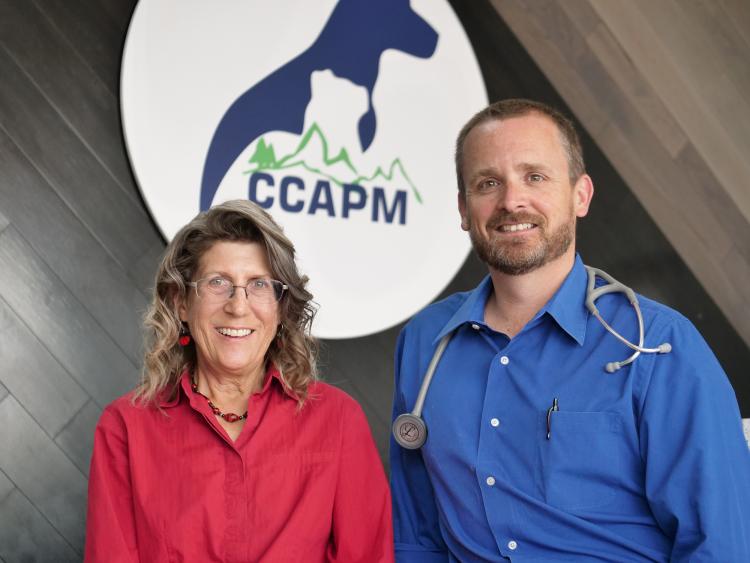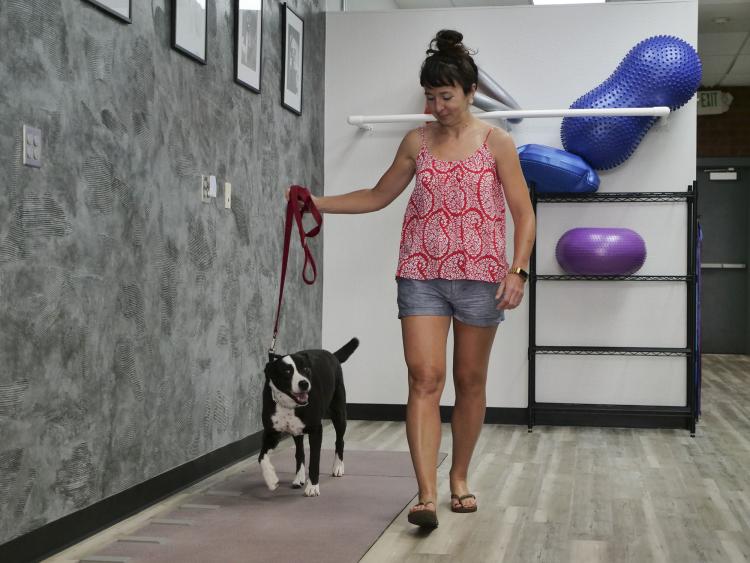Wanted: Dogs with arthritis to help test a novel pain therapy
New study looks to second generation of novel gene therapy as a way to help dogs with joint pain
When dogs develop osteoarthritis, their demeanor changes drastically. Instead of eagerly getting ready for walks, gleefully tossing around toys and excitedly greeting their humans at the door, dogs with this progressive, joint degeneration disease become listless, lethargic and, at times, irritable.
The painful condition makes life difficult for dogs, but it’s also heartbreaking for their owners, who have few options for relieving their beloved pets’ discomfort. Now, a novel gene therapy developed at the University of Colorado Boulder is bringing joy back into the lives of pets and their humans.
“It’s very striking,” said Linda Watkins, CU Boulder Distinguished Professor in the Department of Psychology and Neuroscience. “It’s not just helping the dogs, but when you start talking to owners, they lost their family member. They don’t play anymore or want to go for walks because it hurts so badly. They’ve lost their doghood. And this therapy brings that back. All the things you think of with a happy dog, that comes back again, and owners are so thrilled.”

At the top of the page: Shane the therapy dog was one of the first recipients of this gene-therapy injection invented by CU Boulder neuroscientist Linda Watkins for chronic pain (Credit: Casey Cass/CU Boulder). Above: CU Boulder neuroscientist Linda Watkins and veterinary pain specialist Dr. Rob Landry (Credit: Casey Cass/CU Boulder).
Watkins and Broomfield veterinary pain specialist Dr. Rob Landry are recruiting dogs with severe osteoarthritis (and their owners) to help test the second generation of a non-viral gene therapy in the hopes of moving the improved therapeutic toward a federal veterinary clinical trial.
Dogs that are accepted into the double-blind study must be able to visit Dr. Landry’s veterinary hospital regularly for several months for evaluations and assessments. Participation in the study is free, but owners must pay for an initial consultation to determine the dog’s eligibility or already have an osteoarthritis diagnosis and X-rays.
Dogs in the control group will get a placebo. However, after the initial study period ends, their owners can opt-in to receiving the free therapy as well, Watkins said.
Nature’s anti-inflammatory
Osteoarthritis develops when cartilage—the flexible connective tissue that helps cushion the joints—begins to break down, either because of injury, disease, repetitive use, age or some combination of factors.
This deterioration causes progressively worsening inflammation, which leads to pain, discomfort and decreased mobility. Prolonged inflammation, in turn, leads to further deterioration.
The condition is common among senior dogs and large breeds, but there’s no known cure. It can be so painful and debilitating that some owners opt to euthanize their dogs to end their suffering, Dr. Landry said.
The gene therapy drives the production on a natural protein called Interleukin 10, or IL-10, which the body produces to dial back its own inflammation response to an injury or infection.
“This is nature’s own potent anti-inflammatory,” said Watkins, who co-founded the biotechnology company Xalud Therapeutics to further develop the therapy.
During an initial study at the Colorado Center for Animal Pain Management Veterinary Care Center, Dr. Landry skillfully injected a solution containing circular DNA molecules directly into dogs’ osteoarthritic joints, where it instructed cells within the joint to produce more IL-10, thus reducing inflammation.
In that first round, Watkins and Dr. Landry tried the gene therapy on more than 40 Colorado canine companions, from Siberian huskies to golden retrievers to mixed-breed dogs. They got good results, which led to the launch of human clinical trials for osteoarthritis underway in Australia and California.

Taryn Sargent walks her dog Shane (Credit: Casey Cass/CU Boulder).
After the treatment, participating pups could more comfortably walk, run, go up and down stairs and stand up. Their owners also reported improved quality of life and less pain.
“The dogs are happier and far less dependent on medications,” said Dr. Landry, who is also an adjunct professor in the CU Boulder Department of Psychology and Neuroscience. “It’s amazing research. It’s made impacts on people’s lives for sure, and pets’ lives without a doubt.”
Testing the second-generation therapy
Now, they’ve tweaked the therapy and believe the new version will “come on stronger and last longer,” Watkins said. After years of delay caused by the coronavirus pandemic, they’re ready to begin testing the second generation of the therapy on dogs.
“For IL-10 to do its thing, to be an anti-inflammatory, it has to bind and signal—it has to talk to the other immune cells and tell them to calm down in order to work,” she said. “We’re now encoding not just IL-10 but also giving it this signaling component. We’re making the Il-10 signal much better so it can do its job better.”
With the results of this second dog study, Watkins and Dr. Landry hope to gain approval from the veterinary arm of the U.S. Food and Drug Administration for testing the second-generation therapy in canine clinical trials.
After that, they hope to see widespread adoption of the therapy in veterinary practices across the country.
“Owners should think of this as trying to help their own dog, but it’s also for the greater good of dogs—they can be part of something that can move into an FDA clinical trial to make the world a much better place for dogs with osteoarthritis,” Watkins said.
To determine if your dog is eligible for the study, contact Dr. Rob Landry at Colorado Center for Animal Pain Management Veterinary Care Center in Broomfield.
Online: www.ccapmvetcare.com
Phone: 720-502-5823
Email: office@ccapmvetcare.com

